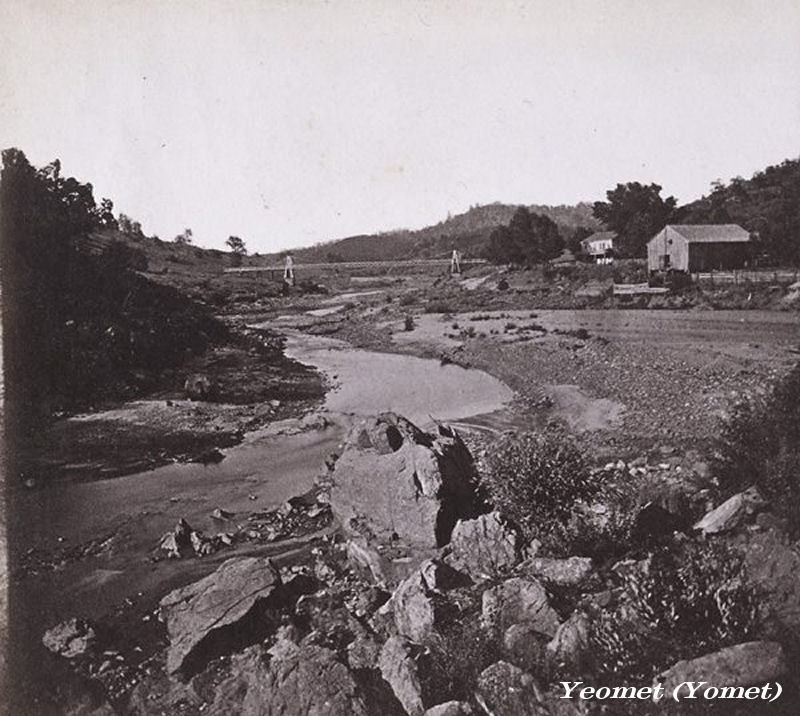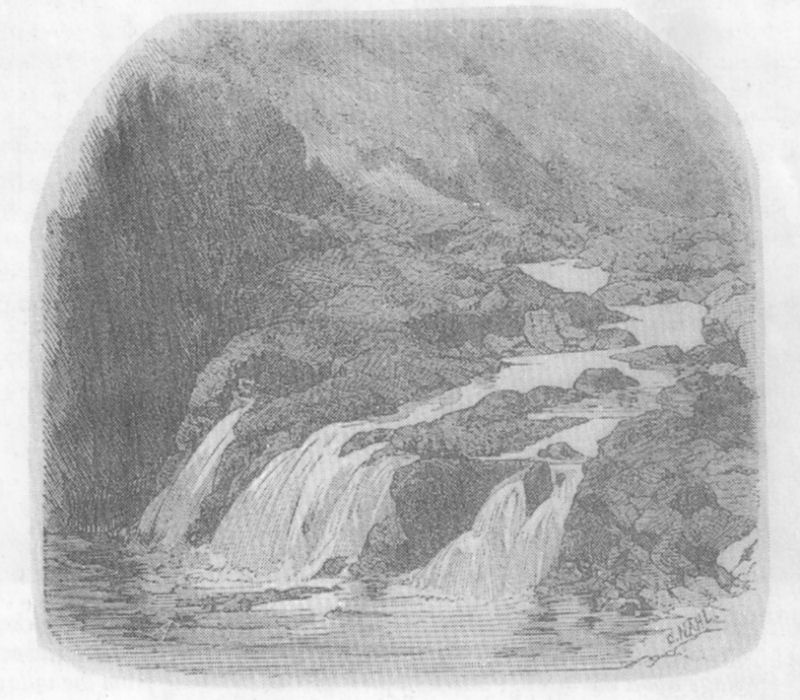





|
|
Yeomet (Yomet), Amador County Ghost Town | ||
|
You cross the Cosumnes on the highway 49 bridge, gently curve northeasterly along the El Dorado side the river, and speed by the spot where the north a middle forks join, and Indian creek enters 300 yards below. Motoring by, it is hard to notice any sign of the "once upona time ... " camp named Yeomet. At that speed one could see the stone abutments of the old suspension bridge just upstream from the new bridge - if one knew they were there and where to look. |
|
|
|
You, Reader, have probably lazed a sultry summer' day in the river's pools below the bridge, and perhaps strolled upstream where once the village stood. Afoot, one can observe other signs that people lived the once, and died, there, too, beside the stream. Circa 1881, historian Jesse D. Mason wrote, "So of the cabins built in 1850 maintain' a tottering standing, with the aid of props and braces. "Inside you may see gold pan and pick as of yore, but the men, weary and worn with a quarter century unsuccessful search for gold, seem waiting for the I act of the play .... " The place was called Yeomet then, an Indian name signifying "rocky falls," Mason wrote, given to the forks of the river. In 1857, too, Yeomet was its formal post office name, though the residents called it "Forks of the Cosumnes." Artist Charles Nahl sketched the falls themselves 1857, and called them "Yeomet" or sounding rock, not the village. Thanks to the state library's files Hutchings magazines, Logan can show you Nahl's sketch now. The earliest account of the place the writer has seen is Jeddo's, appearing in the October 12, 1853 issue the Placerville Herald. In 1853, Jeddo tells us, the place was "Forks of the Cosurnnes" or "Saratoga Village as is now being called." He and later observers agreed that the camp was only naturally beautiful but tastefully beautified by residents and merchants there with trees fences shrubs and fountains. Besides these esthetics, and good placer diggings loosed from the lode by the creek and river paralleling it, the Village featured fountains fed by a natural spring across the river. Carried by a pipe laid in a notch in river bedrock, the spring water had such a head that "in front Bowman's Hotel," Jeddo marveled, "three fountains threw up their sparkling water - sometimes 18 to 20 feet." Jeddo also noted a fish pond nearby held upwards 100 fish, a subject four years later which the Ledger's "Traveler" saw and quipped about. "How'd ya get the fish in there?" "Traveler" queries queries owner Bowman. "Corresponded with 'em," the merchant rejoined. "Corresponded with 'em?" the Traveler puzzled. "What do you mean by that?" "I dropped them a line, "Bowman concluded, punningly. Bowman, a man of obvious wit, also was a man of means, owning the principal hotel, a store, and the bridge in 1853 and at least through 1857. Another fountain in 1857, "Traveler" noted, was in the orchard of Beebe, Simpson and company, with a dozen or more peach trees bearing. Simpson, Mason had a large store there, too. Later, in '63, when "union" politics swept in, it was this Simpson who was elected assemblyman for Amador. In '57 "Traveler" reported that the mining at the forks was confined to quartz (with) ... five arrastras in operation. Before '48, as jeddo wrote, the forks was the great meeting ground along the Cosumnes where great councils, grand fandangos, and sacred burnings of noble Indian dead were held. And a mile below, hyperbolized jeddo, was "a waterfall rivaling in magnificence the celebrated Niagara .... The spot is called by the Indians Yomet or sounding rock where a sound given is echoed and reechoed 10 different times. |
||
|
"Opposite the village, along the river (are) flumes, water wheels and sluices .... Gold is gotten out at the rate of one to five pounds per day per company." Once, 120 years or so ago, it was, Reader, there, upstream from the highway 49 bridge, a village called Forks of the Cosumnes, Saratoga village or Yeomet which really was the Indian name for the falls downstream a mile or so. |
|
|
| ||
Return to Amador County Ghost Towns 
| ||
|
Information, photographs courtesy of the Amador County Archives, The Historical Marker Database, The Chronicling America Database, and Larry Cenotto, Amador County's Historian CONTACT US
|
||

